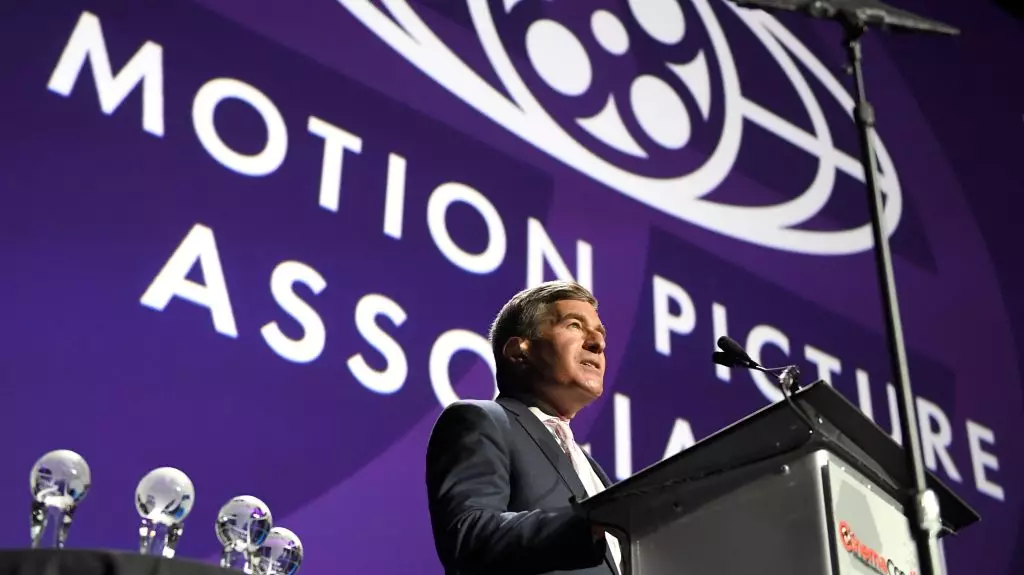In an era where the cinematic landscape is invariably shifting underneath our feet, Charlie Rivkin, the President and CEO of the Motion Picture Association (MPA), has emerged as a beacon of hope for theater owners during his recent address at CinemaCon. Rivkin’s rhetoric signals a profound understanding of the struggles faced by the exhibition industry and a renewed commitment from studio partners to revive theatre attendance. His recognition of the “volatility” felt in the industry resonates with many. After all, theatre owners have had their share of challenges in the wake of the pandemic, which shifted viewing habits and forced a reassessment of distribution strategies.
It is refreshing to hear Rivkin express a shared goal: a desire for vibrant cinemas filled with eager audiences. Theatre owners, who have had to pivot dramatically in recent years, must be encouraged by Rivkin’s sentiments. The long-overdue emphasis on partnership between the MPA and exhibitors lays the groundwork for a collaborative approach to finding solutions amidst uncertainty. Rivkin’s acknowledgment of the need for studios to move away from practices birthed during COVID-19 hints at the urgency for innovation and adaptability in both production and exhibition realms.
Commitment to Theatrical Releases
One of the most significant announcements was Amazon MGM Studios’ pledge to release between 12-14 films in cinemas next year. This commitment not only signals a strong resolve towards theatrical exhibition but also embodies a larger trend towards reinstating the primacy of cinemas in the distribution chain. Rivkin’s words indicate that, despite fluctuating box office revenues, major studios are recognizing the value of the theatrical experience and the communal aspect of film viewing. This is a vital message, especially when many have lamented the decline of theaters in favor of streaming services.
The dedication to bringing more films to theaters is not merely about quantity; it’s about quality as well. Audiences crave exclusive cinematic experiences that only the big screen can provide. Rivkin’s enthusiasm surrounding the notion of storytellers producing stories in diverse locales through enhanced incentives illustrates a roadmap to enriching the theater-going experience. The emphasis on the importance of local economies being engaged in the production of films should resonate across all states, galvanizing disparate regions to attract more film projects.
Economic Impact of Film Production
The MPA’s advocacy for film production as a vital economic driver is significant. Rivkin’s assertion that a major motion picture can inject approximately $1.3 million a day into local economies, engaging nearly 1,600 local hires at wages far above the national average, paints a compelling picture for policymakers. This perspective highlights the intrinsic value of film production beyond just artistic expression. It positions filmmaking as a keystone of economic revitalization, especially as communities grapple with post-pandemic recovery.
California’s recent incentive measures, resulting in a record 51 films qualifying for tax credits, serve as a prime example of how strategic policy-making can stimulate economic growth while simultaneously rejuvenating the film industry. Rivkin’s emphasis on sharing these successes provincially fosters an understanding that film production can engender substantial job creation, bolster local businesses, and amplify cinema attendance.
The Imperative of Federal Advocacy
Rivkin’s call to action isn’t just about local initiatives; it extends to the federal level—a call for renewed advocacy for tax measures that fuel production investments. A united front with Union and Guild partners signifies a concerted effort towards sustainable growth in American filmmaking. This collaborative spirit reflects a broader recognition that concerted civic engagement and policy advocacy are essential to uphold America’s prestige in global film production.
Rather than accept a creeping inevitability of decreased cinema attendance or reliance on streaming platforms alone, the MPA’s blueprint encourages a proactive approach. Sustaining a future of American leadership in production necessitates unwavering resolve, forging alliances with both industry insiders and external stakeholders. Together, they can combat the prevailing challenges, ensuring that cinemas remain vibrant venues for storytelling, community engagement, and economic prosperity.
Rivkin’s address at CinemaCon encapsulates a moment of rejuvenation for the film industry. Through partnerships, renewed commitment to theatrical releases, and a strong economic narrative, the MPA is laying the groundwork for a renaissance of cinema, one where theaters thrive once more. As audiences eagerly await these developments, the industry’s response to the call for action could very well define the future of film exhibition in America.
